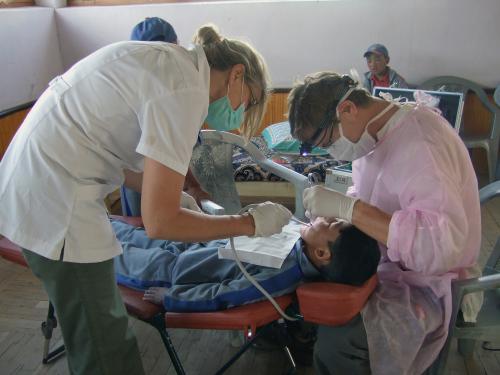Dr Vivienne Levy journeys deep into India to help with the local tooth decay epidemic. ..
Ladakh Is an extremely remote region of India situated on the
north side of the great Himalayan mountain range on the vast
Tibetan Plateau. Bordering Pakistan to the east and China to the
West. The largest town in Ladakh is Leh at an altitude of 3500m
(10500 ft ). The majority of Ladakhls are Tibetan Buddhists and
the rest are mostly Sunni and Shite Muslims.
Ladakh is renowned for its remote mountain beauty and culture. It
is sometimes called ‘Little Tibet’ as It has been strongly influenced
by Tibetan culture. In the past Ladakh gained importance from
It’s strategic location at the crossroads of Important trade routes,
but since the Chinese authorities closed the borders with Tibet
and Central Asia in the 1960s, international trade has dwindled
except for tourism. Since 1974 the Indian Government has
successfully encouraged tourism In Ladakh although the strong
Indian military presence shows that it still remains a disputed
territory, between India and Pakistan and India and China.
After centuries of isolation the Ladakhi people were suddenly
thrust into the ‘outside’ world when the Indian army established
military bases there to defend the country against their political
adversaries in Pakistan. The military presence brought many
advantages besides security like roads. airports, communication
and the now flourishing tourist trade. It also introduced refined
sugar Into the diet of Ladakh Inhabitants. and in a very short time
tooth decay was an epidemic.
The only way into Ladakh in winter is by a spectacular one-hour
night that lifts one out of the urban Intensity of New Delhi and over
a virtual sea of snow-capped Himalayan peaks, before landing at
the ancient city of Leh in tne Indus River Valley. In winter there
is only one flight a day in and out of Leh. In the summer months
(April to October) there are more flights and the passes are open
for vehicles – a two-day drive to either Srinigar or Manali.
Thanks to an American philanthropist, Bill Kite. who spends
his time living and working between Ladakh. Kathmandu and
Redcllffs (Christchurch), a small dental clinic has been set up
in Lamdon School, Leh. This local school has over 1,400 students and
a staggering 100% prevalence of untreated tooth decay. Not a
dental clinic as such, but a portable dental unit, hand instruments
and dental materials are stored at the school to be used by
visiting volunteer dental professionals.
In August 2008 I flew to Ladakh together with another dentist
Steve McKinstry, my dental assistant Heather Tayler and a
non-dental friend Vangi Well who learned very quickly all about
assisting during extractions.
It took us about two days to acclimatise properly to the altitude – I
learned not to run up the flight of stairs to my hotel room very early
on as it would make me rather light headed and dizzy. Heather.
unfortunately. had a pounding headache for several days.
We set up in the school hall. One of us working the portable
dental unit doing restorations while the other dentist worked
on extractions on one of the beds. Conditions were often
overwhelming with the sheer numbers of students in need of
urgent dental care, but we worked long, hard days to treat as
many patients as possible. Over 12 days we would have treated
almost 400 children between us.
Most of our patients were from the school, aged between 5-18
years. Teachers and families of the students were treated too. Most
of the extractions were first and second permanent molars. After
only a few years in the oral cavity. they were worse than anything I
had seen in general practice in UK and NZ over the 22 years of my
professional career. And all these extractions were done with no
X-rays or surgical equipment! I am proud to state that in two weeks
of extracting these teeth I only left one root in situ.
In addition. the Lamdon School nurse, Ms Yangchen Dolma
has received training over the last few months in basic dental
procedures and will follow-up with basic treatments full time
on campus as well as be able to assist with procedures and
translations with any visiting dental team.
We were very well looked after. Our accommodation and food
was paid for. we were invited into people’s homes. shared their
meals. taken to various Buddhist monasteries and even drove
up to the highest motorable road in the world – 5.359m (17.582
feet). just short of the full height of Kilimanjaro.
Certified dental professionals, dentists, dental therapists and
hygiensts, who volunteer to come to Ladakh and contribute
their skills toward (he goal of providing dental health care to the
hundreds of children of Lamdon School will gratefully be provided
all accommodations and meals, tours of the Indus river valley
accompanied by Buddhist scholars and treks around the area.
Contact Viv Levy: coxst@cybenrpress.co.nz for more information
Thanks to the following for their generous donations:
lvoclar. Henry Schein Shalfoon, 3M Espe and Kim Hughes, dental
surgeon-Christchurch.




